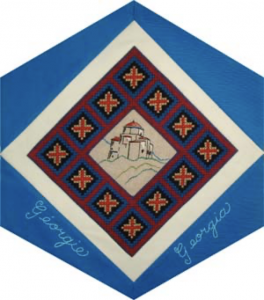Georgia

The Block
The underlying themes of peace and prosperity, selected by Diana Tsertsvadze-Smirnoff, were realized on the Georgia block through the skilled hands of Elfriede Petric. The block’s central image is a beautiful church, resting high atop the Abkhasia Mountains that reflects both the country’s rich architectural history and its pride at being one of the world’s oldest Christian nations. The church is surrounded by a cross-stitched frame of deep wine, tan, black, and cobalt squares that replicate a typical Georgian pattern.
Embroidery in Georgia is introduced to girls at an early age by female relatives as well as in school. As they become more adept, embroiderers explore their individual creativity by continuously adding personal touches to basic patterns while maintaining the original design. The fact that patterns are never repeated exactly makes Georgian embroidery unique. It has become known for its fluid, delicately nuanced designs and has long been a highly respected and valuable art form throughout the Caucasus. Popular needlework motifs include flowers, birds, animals and grape vines depicted in rich textures of locally produced colourful wool and interwoven with threads of gold and silver.
Cultural Profile
Sandwiched between Russia and Turkey, Georgia lies along the eastern edge of the Black Sea. It is a land of mountains and fertile slopes, which, in addition to the warm climate, makes Georgia a perfect place for growing tea, citrus fruit and grapes. Indeed, Georgia is said to have the oldest wine-making tradition in the world with archeological evidence showing that wine was made in 7,000 BC in this area. In spite of its relatively small size, Georgia is covered with a huge variety of flora, a result of the combination of western and eastern climates. It is home to over 100 species of animals, over 330 species of birds, 48 species of reptiles, 11 species of amphibians and about 160 species of fish.
The country’s often-times combative history has created a proud people still willing to fiercely defend their independence. Georgians typically live long and healthy lives and more citizens living there surpass the age of one-hundred than anywhere else in the world. Almost the entire population is comprised of Georgians, while various smaller groups, including Azeri, Armenian and Russian make up the remainder. The official language is Georgian, which can be written in three different alphabets.
Georgia’s location at the junction of Europe and Asia has, over thousands of years, led to the development of a diverse and moderate culture, influenced by a variety of sources. The country has a long and vibrant history of metalwork created with intricate designs. Locally produced silk, cotton and wool feed a centuries-old tradition of spinning and weaving. Such pursuits provide numerous opportunities to wear elaborate and skillfully embroidered costumes.
Georgia’s national dress is a canvas on which to exhibit one’s expert and creative embroidery skills. Women’s ankle-length gowns of rich materials like damask, brocade, or silk are closely fitted at the waist, and the bodice, cuffs and belt showcase exquisite needlework. The costume includes a headdress made from a roll of silk cloth and embroidered fillet or chihta and is completed with a white, transparent kerchief framing the face. Men’s traditional costume include the Chokha, a long, thick tunic tighter at the waist and featuring a masrebi, a string of bullets, on the chest. It has become a symbol of national pride since the Revolution of Roses in 2003, a nonviolent protest movement that resulted in government change.
These traditional costumes are also part of the dramatic arts Georgians love, such as theatre, dancing, folk-singing and choral groups. The country is especially known for its polyphonic singing which takes place during celebrations such as weddings and feasts. Larger choirs will perform more formal songs. The singing during feasts, called supras, is very often improvisatory in nature with all guests expected to sing. The chianuri is a traditional stringed instrument played with a bow and made from tree bark that often accompanies traditional singing in Georgia. It is so sensitive to humidity in the air that weather forecasts can be made just by listening to the sound it produces.
Georgia has only been listed under Canadian Immigration records since 1993, following the dissolution of the Union of Soviet Socialist Republic in 1991. As of 2011, there were over 3,000 Canadians of Georgian ancestry in Canada.
Sponsor: Catholic Ladies Guild, St. Mary’s, Williamstown
